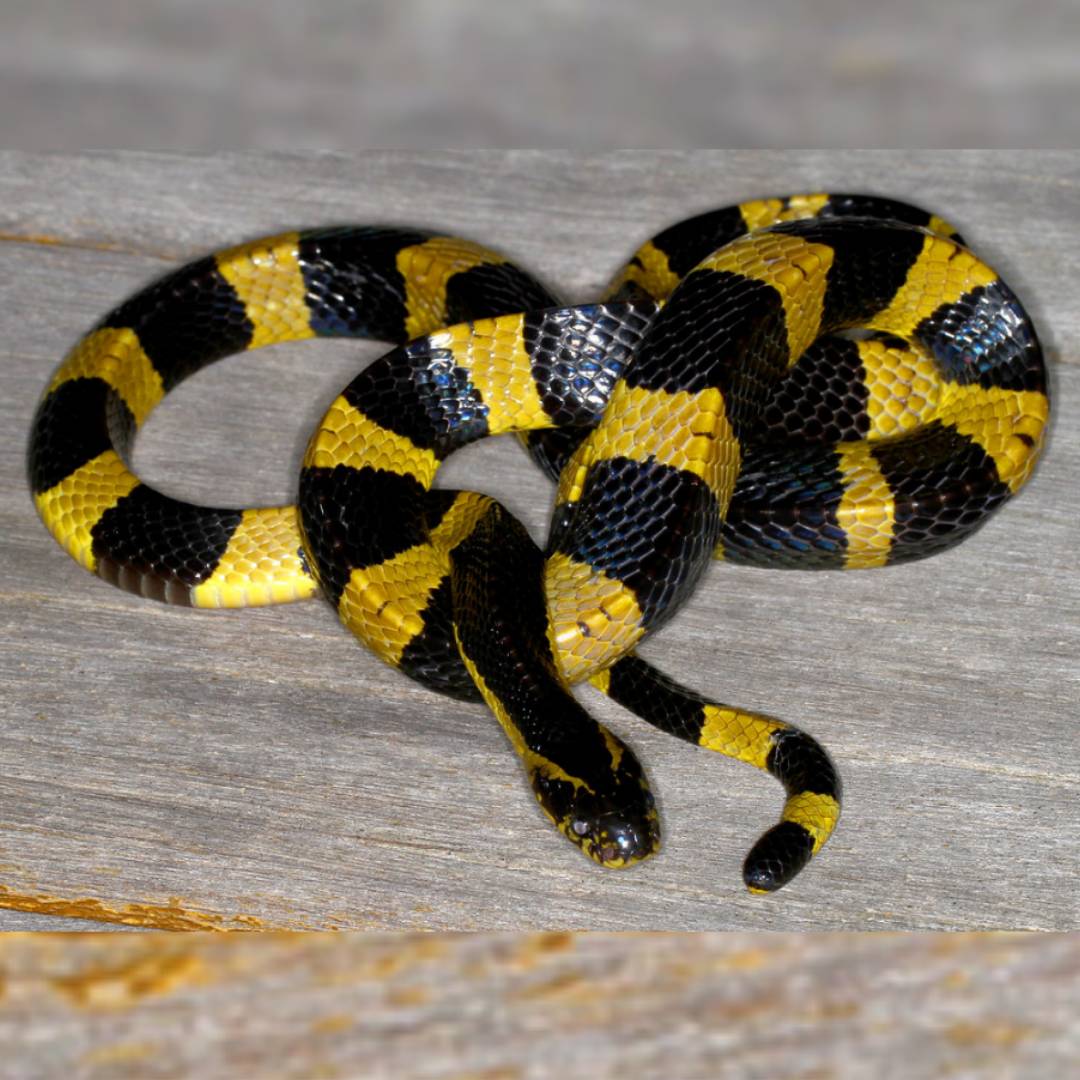








EXTREMELY VENOMOUS
Banded krait
(Bungarus fasciatus)

Banded krait (Bungarus fasciatus) is small size snake.
Average length :
4-5 feetMaximum Recorded :
7.5 feet

Banded krait (Bungarus fasciatus) feeds on Its primary diet consist of other snakes but is also seen to eat fish, frogs, skinks, and snake eggs. it has been seen feeding on cobra and common krait also.

Banded krait (Bungarus fasciatus) are very shy docile and lethargic not easily seen, and are primarily nocturnal. When threatend, they make a coil and hide their head under it, and rarely attempt to bite but at night they are more active and dangerous. During the daytime, they hide themselves grass, pits, or drains. The snakes are sluggish and even under provocation they dont attempt to bite but just give a jerky movement. They are commonly seen in the rains.

Banded krait (Bungarus fasciatus) lives in a wide variety of habitats, from Forests to agricultural lands. They inhabit termite mounds and rodent holes close to water, and often live near human settlement, They prefer the open plains of the countryside.

Banded krait (Bungarus fasciatus) can be found some part of India
India :
AndraPradesh, Arunachal Pradesh, Assam, Bihar, Chhattisgarh, Jharkhand, Madhya Pradesh, Maharashtra, Manipur, Meghalaya, Mizoram, Nagaland, Odisha, Sikkim, Telangana, Tripura, Uttar Pradesh, Uttarakhand, West Bengal.Other Countries :
Nepal, Bangladesh, Myanmar, Cambodia, Thailand, Laos, Vietnam, and southern China, Hong Kong , Malaysia, Indonesia,Singapore.

Banded krait (Bungarus fasciatus) is extremely venomous snake, with venom is primarily contains neurotoxins (pre- and postsynaptic neurotoxins) , its venom also contain bungarotoxins. Venom effects include vomiting, abdominal pain, diarrhoea, and dizziness, respiratory failure and death may occur due to suffocation. Banded krait venom can also damage the kidneys. Visit for more information on "Types of venom in Indian snakes" and "LD₅₀ Toxicity Chart of Indian snakes" .

Banded krait (Bungarus fasciatus) stay and guard their clutches until the young hatch. At birth, the hatchlings are about 250mm to 400mm (25cm-40cm)long
Oviparous :
Lays eggs. (for more details on "Types of Reproduction in Snakes")Mating season :
Dec-MayIncubation period :
about 60 daysClutch size :
4 – 14 eggs

Banded krait (Bungarus fasciatus) is Classified as Least Concern. Threats include habitat loss, accidental killings, and snakebite-related deaths, skin trade, black magic.
Manipuri language :
linkhakMizo language :
chawnglei, tiangsirKannada :
kattige haavu (ಕಟ್ಟಿಗೆ ಹಾವು)Karbi language :
maipam, rui-teronAssamese language :
xokha (শখা), xongkhosur (শংখচোৰ), gowala (গোৱালা), bandphoraBengali :
shankhini (শঙ্খিনী), shankhamooti shaanp (শাঁখামুঠি) and rajsap (king snake) in Birbhum District কুসাপা (রাজবংশি ভাষায়)Burmese :
ငန်းတော်ကျား ngān taw kyāHindi :
ahiraaj saampIndonesian :
welangMalayalam :
manjavarayan (മഞ്ഞവരയൻ)Marathi :
patteri manyar, पट्टेरी मण्यार agya manyar, sataranjyaOdia :
rana (ରଣା)Tamil :
kattu viriyan (கட்டுவிரியன்), yennai viriyan, yettadi viriyanTelugu :
katla paamu (కట్ల పాము) or bangaru paamu (బంగారు పాము) meaning the golden snakeTulu :
kadambaleThai :
ngu sam liam, งูสามเหลี่ยม, meaning the triangular snakeVietnamese
rắn cạp nongNepali :
गनगलि, गनग्वली, राजा साप वा सर्प gangali, gan gwali and Rajasaap (king of snakes) in NepalMaithili – मैथिली :
गन गुआर
Local names:
Interesting Fact

Banded krait (Bungarus fasciatus) easily hunt on Russells viper, cobra and common krait.











